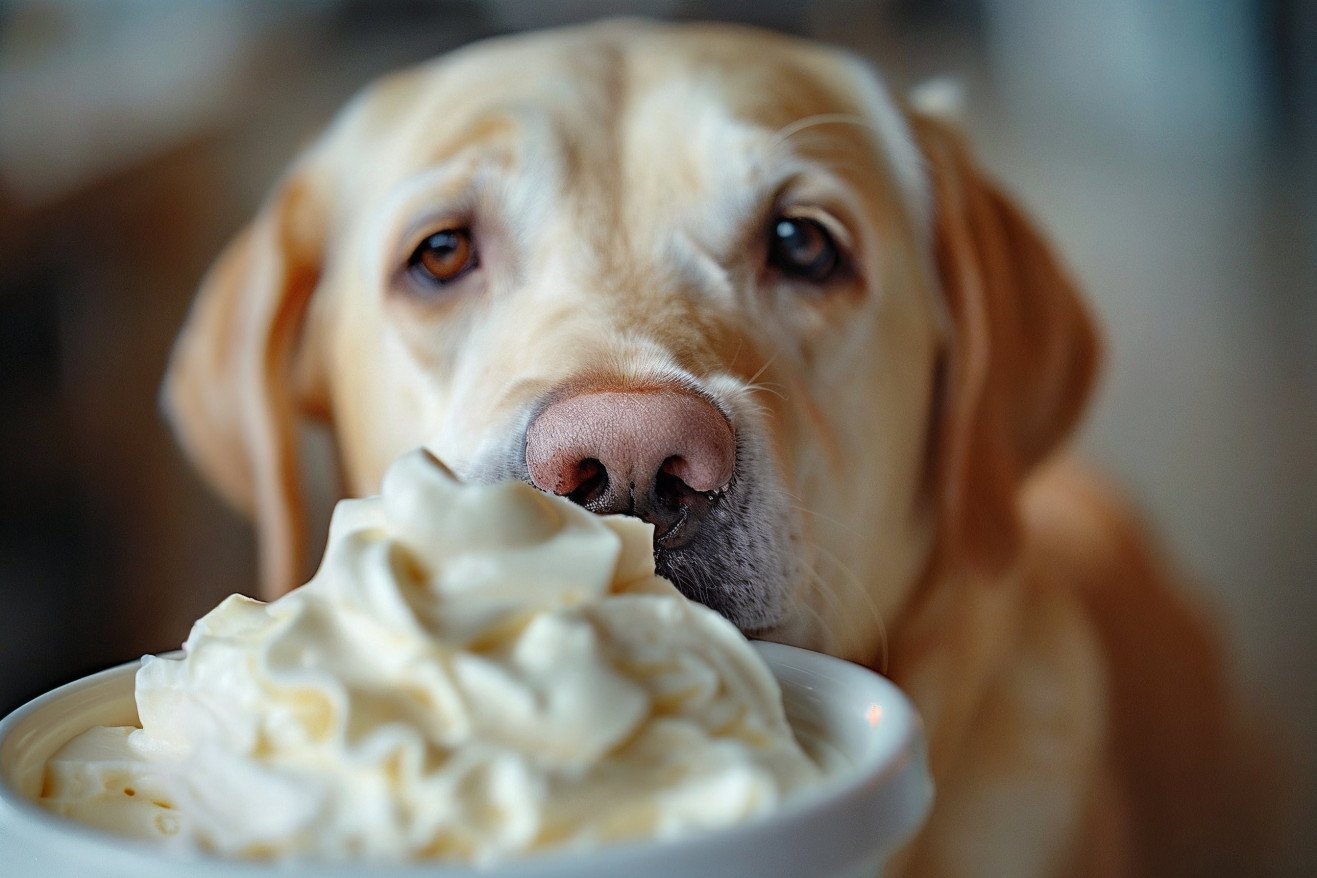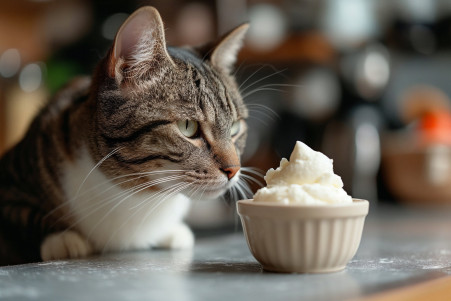Can Dogs Eat Cool Whip? What to Know About This Treat
31 March 2024 • Updated 31 March 2024

If you’ve ever found yourself about to enjoy a spoonful of that fluffy whipped topping, only to look down and see your dog staring up at you with those big, begging eyes, you might have wondered if it’s safe to share your treat with your furry friend. The answer is that it depends on the ingredients in the cool whip and how much your dog eats. In general, cool whip is safe for dogs to eat in moderation, but it’s not something you should share with your pet regularly. Cool whip contains a few potentially harmful ingredients, including sugar and artificial flavors, but it’s unlikely to cause any serious issues unless your dog eats a large amount.
Dogs don’t require the sugar and empty calories found in cool whip, but we’ll take a look at the studies that have been done on the potential effects and risks of giving your dog this human food on occasion. We’ll also find out from veterinarians, dog nutritionists, and animal behaviorists whether or not it’s a good idea to let your dog have this sweet treat.
Can dogs eat Cool Whip?
What's in Cool Whip?
There are a number of ingredients in Cool Whip that pet parents may want to consider before giving this dessert to their furry friends. According to The Goody Pet, Cool Whip is made with water, hydrogenated vegetable oils, high fructose corn syrup, artificial flavors, and other additives like guar gum and polysorbate 60. Most of these ingredients aren't very nutritious for dogs.
One of the biggest problems is the high sugar content that comes from the high fructose corn syrup and other sweeteners. According to a study cited by The Goody Pet, this can lead to weight gain, hypertension, and diabetes in dogs. The hydrogenated oils are also hard for dogs to digest.
Although Cool Whip doesn't contain xylitol, an artificial sweetener that is highly toxic to dogs, some of the other ingredients in Cool Whip, such as artificial flavors, can cause allergic reactions or other issues in some dogs, according to Rocky Kanaka. As a result, while most dogs can probably handle a small amount of Cool Whip from time to time, it's not the healthiest option for a regular treat because of its highly processed, low-nutrient ingredients.
Everything in Moderation: Portion Control
While Cool Whip is safe for dogs in small amounts, it should only be given to your pet as an occasional treat. To ensure that you don't overdo it, veterinarians recommend that no more than 10% of your dog's daily calories come from treats like Cool Whip.
The Dodo suggests that you stick to 1-2 tablespoons for small dogs and up to 3 tablespoons for larger dogs. However, it's important to pay attention to your pet's individual tolerance to new foods, especially since some dogs may be more sensitive to certain ingredients, including the artificial flavors and high sugar content in Cool Whip.
In fact, JustAnswer warns that even small amounts of xylitol, an artificial sweetener that is sometimes used in sugar-free versions of the product, can be poisonous to dogs. To prevent potential digestive upset and other issues, make sure to practice portion control when giving your dog treats like Cool Whip.
Healthier Alternatives to Cool Whip for Dogs
For dogs that are lactose intolerant or sensitive to dairy, coconut whipped cream is a great alternative. According to Spoiled Hounds, coconut whipped cream is created by whipping full-fat coconut milk that has been chilled, and it offers healthy fats and no added sugars. Nuesta Pets also suggests making your own whipped cream with coconut cream to avoid any lactose issues.
Egg white whipped cream is another alternative that provides a high-protein, low-cholesterol option for dogs, according to Sundays for Dogs. In addition, homemade treats like frozen yogurt or purees made with dog-safe fruits can offer a sweet, yet more nutritious option than Cool Whip.
While Cool Whip can be a rare treat, these homemade alternatives can offer dogs a whipped, creamy treat without the artificial ingredients and high sugar content that Cool Whip contains.
Whipped Cream vs. Cool Whip: What's the Difference?
Although regular whipped cream is made from dairy and therefore generally healthier for dogs than Cool Whip, it's still high in fat and calories, so it should be fed in moderation, especially to dogs that are overweight or have sensitive stomachs. As the Yahoo Finance article notes, "Whipped cream is, well, cream that's been 'whipped' into its tasty, fluffy state. Sugar, vanilla, and other flavorings are added for taste." This means that while whipped cream is less processed than Cool Whip, it can still be harmful if consumed in large amounts.
If your dog is lactose intolerant, you may want to opt for a dairy-free alternative like coconut whipped cream. In addition, the Furtropolis article warns that some whipped cream brands contain artificial sweeteners like xylitol, which is extremely toxic to dogs and should be kept away from them at all costs. As with Cool Whip, it's important to check the ingredients of any whipped cream you plan to give your dog to make sure it's safe.
Signs of Potential Toxicity or Digestive Issues
If a dog eats too much Cool Whip or other whipped cream products, it can lead to digestive issues, such as vomiting, diarrhea, or gas. The Pet Poison Helpline notes that nausea, vomiting, and diarrhea are all symptoms of many different types of poison exposure and can be an early sign of toxicity. Other signs of potential toxicity include excessive drooling, difficulty breathing, swelling, and changes in body temperature.
Dogs with certain health issues, such as pancreatitis, diabetes, or obesity, may be more prone to negative reactions, according to The Dodo article. If you believe your dog has ingested a toxic substance or is showing severe symptoms, it's important to get them to a vet right away. Failing to do so can result in complications or even life-threatening issues for your dog.
Conclusion: Moderation and Mindfulness for Furry Friends
Although Cool Whip and other whipped cream products can be safely consumed by dogs in moderation as an occasional treat, they should not be included in a dog's regular diet. Pet parents should be sure to check labels and avoid products that contain ingredients that are toxic to dogs, such as xylitol.
It's also important to make sure that dogs are eating appropriate portion sizes and to be aware of any adverse reactions to new foods. Healthier, homemade options like coconut or egg white whipped cream can offer a more nutritious and safer treat for dogs.


